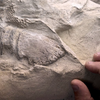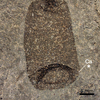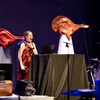What was dinosaur armor used for? New fossils help scientists find out!

Above: The immaculately preserved Borealopelta fossil!
Post author - Ellis Nolan
While teeth and claws are usually the show-stoppers when it comes to fossils, of equal interest to scientists are plates, clubs, and spikes. While originally thought to have been developed by herbivorous dinosaurs to defend against their carnivorous counterparts, newly discovered specimens are leading researchers to draw new conclusions about the purpose of dinosaur armor.
Two recent discoveries prompted scientists to reconsider the role of armor for herbivorous dinosaurs. Both fossils were large, armored, herbivorous dinosaurs, and were found in Canada. Most notably, though, both of these fossils have large portions of their bodily tissue still intact. The first, discovered in 2011, is named Borealopelta, and consists of the ankylosaurid’s head, as well as most of its armored neck and back. The other fossil, named Zuul after the character from Ghostbusters, contains the dinosaur’s club-tail and horned head. What is particularly striking (pun intended) about Zuul is that scientists believe its tail was struck at one point by another Zuul!
Before the discovery of these fossils, the consensus on dinosaur defenses was that their horns, osteoderms (a fancy word for armored skin), clubs and tail spikes were mostly made up of bone, but protected by a thin layer of keratin, the material that makes up humans’ hair and nails, and in animals, hooves and horns. This was because keratin is usually not preserved when a dinosaur becomes fossilized. However, upon analysis of Borealopelta, the researchers discovered the preserved keratin in the fossil increased the armor plates’ sizes by up to 40%, much more than previously imagined.
The researchers quickly realized these extra massive spikes and horns would be much more than necessary to combat a predator, so what were they used for? One theory: to fight other dinosaurs of the same species! One researcher imagines these dinosaurs’ defensive features as analogous to the horns of a mountain goat: rarely used for defense, mostly for fighting over mates and territory.
With this new research, updated visualizations have been created to account for the larger armor sizes, changing our previous understanding of these herbivores. Our picture of the age of dinosaurs is constantly evolving and there is always more to learn about the lives of such fascinating creatures.
You can have your own fossilized piece of an Ankylosaurus's fascinating armor! It is an amazing example of the evolving image of these creatures. Click here to learn more!
Featured Product
Joe Frazier Boxing Glove
Cool Things!

Is “Paul is Dead” Dead?: Unpacking One Of Pop Culture’s Most Enduring Conspiracy Theories

Scientists Discover Hooves and Skin in Preserved Dinosaur "Mummies!"
A dinosaur discovery just in time for Halloween! In a new analysis of a group of fossils from Wyoming, Scientists have determined this group of fossils are dinosaur “mummies,” with preserved skin and even hooves.

Scientists Record a Bat Catching Birds Mid-Flight!
Bats, birds, screeches, oh my! In a reverse-Hitchcock twist, a new study reveals that a species of European bat catches and eats birds mid-flight.
Specimen Deep Dives

The House that Ruth Built: The Story of the Old Yankee Stadium

The Queen of the Skies: the Story of the Boeing 747

Old Ironsides: The USS Constitution and the Start of the U.S. Navy
Long Form Articles

The Artist Behind the Macintosh: Susan Kare and Apple Computers
While the two Steves, Jobs and Wozniak, are the most well known faces behind Apple computers, equally important to the products and culture of the company were those who crafted the experience of using their computers through design. The most notable of these visual architects was Susan Kare, a designer responsible for “humanizing” Macintosh computers.

Can I Lick It? Yes You Can!
Have you ever been unable to tell if a fossil was really a fossil, but you were too embarrassed to admit it? Have you ever wanted to lick a fossil just because, but you didn’t want to risk judgment from your peers? Well, good news! You can kill two birds with one stone! Licking a fossil can actually help you determine if it’s the real deal or just another rock.

Is It Legal To Own a Meteorite: How to Start Your Outer Space Collection!
Meteorites are some of the rarest geological specimens to be found on Earth. Of course, since these stones are not of our world, purchasing them can sometimes be a confusing process. Is it legal to own a meteorite? In short, yes! Read on for help starting your cosmic collection!



















